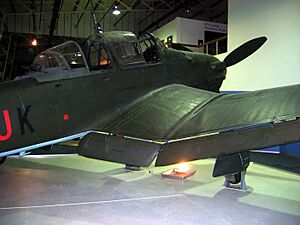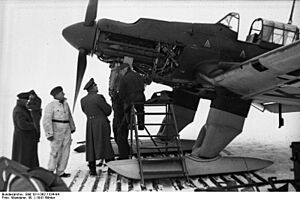Sturzkampfflugzeug facts for kids

The word Sturzkampfflugzeug comes from the German language. It means "dive bomber" and is often shortened to Stuka. A dive bomber is a special kind of aircraft that flies straight down towards its target to drop bombs very accurately. The two most famous planes called Stukas were the Henschel Hs 123 and the Junkers Ju 87.
Contents
What is a Dive Bomber?
A dive bomber is an airplane designed to attack targets on the ground or at sea by diving steeply. This steep dive helps the pilot aim the bombs much more precisely than if they dropped them from level flight. After dropping its bombs, the plane pulls up sharply and flies away.
Why were Stukas used?
Stukas were very effective because they could hit small targets with great accuracy. This made them useful for destroying things like tanks, bunkers, or ships. They were also known for a loud siren, called the "Jericho Trumpet," which made a terrifying sound during their dives. This sound was meant to scare people on the ground.
The Famous Junkers Ju 87 Stuka
The Junkers Ju 87, often just called the Stuka, was the most well-known dive bomber used by Germany during World War II. It first flew in 1935 and was used in many battles.
Design of the Ju 87
The Ju 87 had a very distinct look. Its most famous feature was its "inverted gull wings," which bent downwards and then upwards, like the wings of a seagull in flight. It also had fixed landing gear, meaning the wheels did not fold up into the plane. This made it slower but also simpler and tougher.
The "Jericho Trumpet" Siren
One of the most memorable things about the Ju 87 was its siren. This siren was attached to the landing gear and made a loud, wailing noise as the plane dove. It was designed to create fear and confusion among enemy soldiers on the ground.
How the Ju 87 was used
The Stuka was mainly used to support ground troops. It would fly ahead of the army, bombing enemy positions and helping to clear the way. It was very successful in the early parts of World War II, especially during the invasions of Poland and France.
Challenges for the Stuka
As the war went on, the Stuka faced more challenges. It was slow and not very agile, which made it an easy target for faster enemy fighter planes. Because of this, it needed strong protection from other German fighter planes to survive in battle.
Stukas in Different Climates
Stukas were used in many different parts of the world, from the hot deserts of North Africa to the freezing cold of the Eastern Front in Russia. To handle the harsh winter conditions, some Stukas were fitted with skis instead of wheels for landing on snow and ice.
Legacy of the Stuka
Even though the Stuka eventually became outdated, it played a big role in the early years of World War II. It showed how powerful air support could be for ground forces. Today, some Stukas are preserved in museums around the world, allowing people to see this famous aircraft up close.
Images for kids
-
Junkers Ju 87 B during the Battle of Stalingrad.
See also
 In Spanish: Junkers Ju 87 para niños
In Spanish: Junkers Ju 87 para niños





























